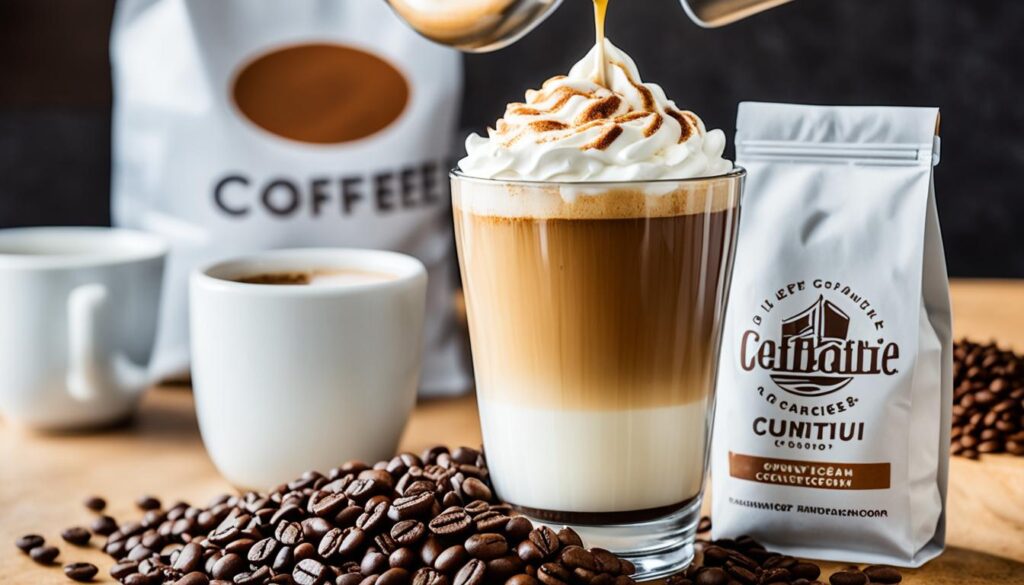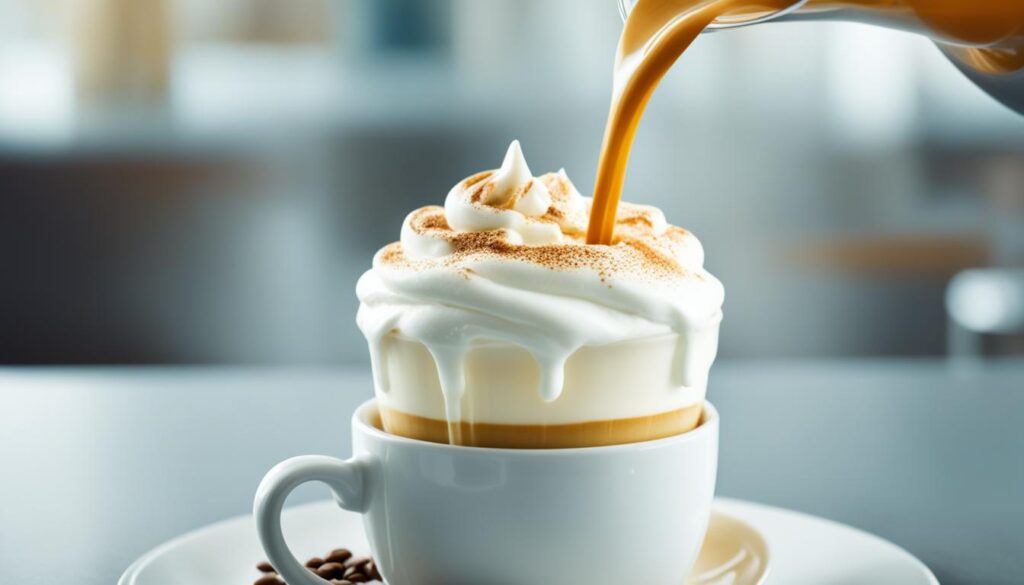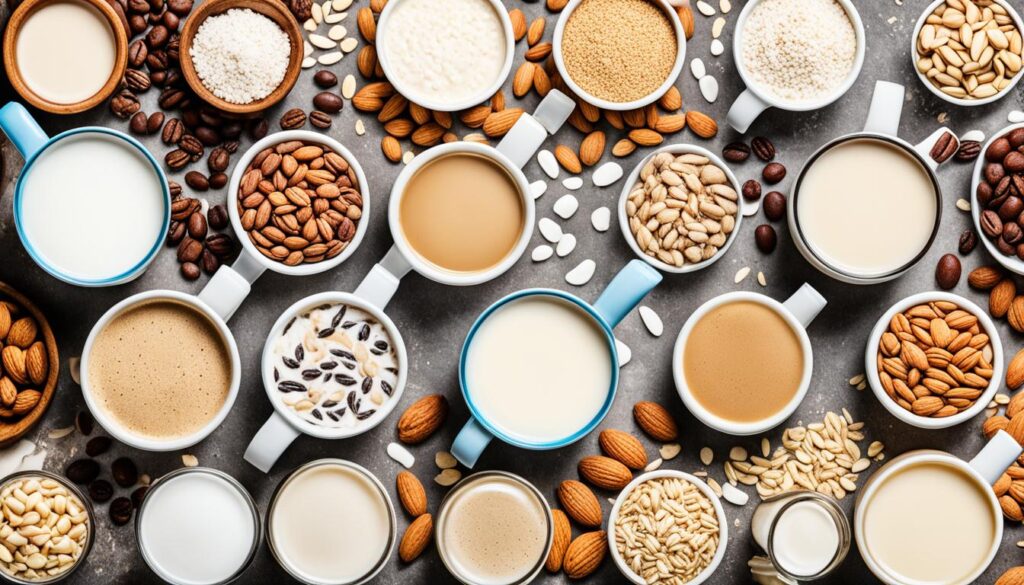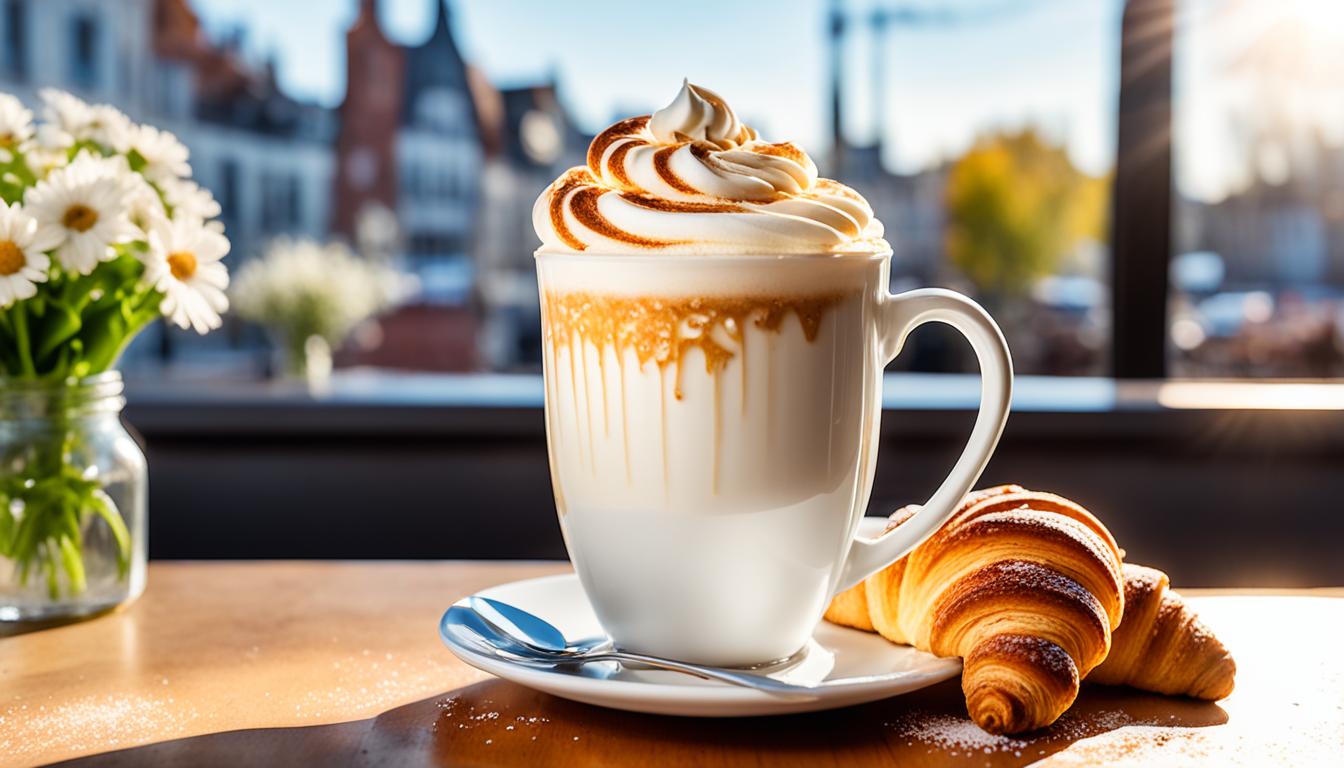Have you ever thought about whether there’s a richer, more indulgent option for your regular coffee creamer? If you’re looking for a bold coffee flavor, heavy whipping cream could be the solution you’ve been searching for. With a minimum of 36% fat, it provides a creamy texture and richness that elevates your coffee enjoyment. However, before making the change, there are various factors to think about, such as calorie management and flavor exploration.
Curious about how to properly integrate heavy whipping cream into your coffee and whether it’s the right choice for you? Let’s dive into the details.
Key Takeaways:
- Heavy whipping cream contains at least 36% fat, offering a thick, creamy consistency.
- It enhances the richness and smoothness of your coffee.
- Start with a small amount and adjust to preference to manage calorie intake.
- Proper mixing techniques prevent curdling and ensure a smooth blend.
- Experiment with adding sweetness or other flavors for a personalized touch.
- Despite its high-calorie content, heavy whipping cream is less processed than many commercial creamers.
What is Heavy Whipping Cream?
Heavy whipping cream is a rich and versatile dairy product derived from the fattest part of milk. It boasts a milk fat content ranging from 36% to 40%, making it one of the thickest and most decadent variants available. Due to its high fat content, heavy whipping cream is a favorite choice in creating smooth and creamy textures in various recipes, particularly in cream in desserts and baking applications.
Manufacturers adhere to strict guidelines to ensure that heavy whipping cream contains at least 36% milk fat, though the exact percentage may vary by brand. This high fat content allows the cream to whip readily, forming stiff peaks that add volume and firmness to a variety of dairy products. The cream’s ability to form stiff peaks makes it an essential ingredient in culinary creations such as whipped toppings, mousses, and other confections.
Heavy whipping cream typically undergoes pasteurization to ensure safety and consistency. The pasteurization process heats the cream to a specific temperature to eliminate harmful bacteria without affecting its rich, creamy taste. In some cases, the cream may also be homogenized or ultra-pasteurized to extend its shelf life while maintaining the desired texture and flavor.
Here’s a detailed look at the key attributes of heavy whipping cream:
| Attributes | Description |
|---|---|
| Milk Fat Content | 36% to 40% |
| Uses | Desserts, baking, whipping |
| Processing Methods | Pasteurized, homogenized, ultra-pasteurized |
| Texture | Thick, creamy |
Can You Use Heavy Whipping Cream in Coffee?
Yes, you can use heavy whipping cream in coffee. Incorporating it as one of your coffee additions can significantly enhance the flavor by cutting coffee bitterness and creating a velvety, creamy texture.
Heavy whipping cream blends exceptionally well with the natural oils in coffee, making it an ideal choice for those looking to elevate their daily cup. Its ability to reduce bitterness is particularly beneficial, offering a smoother, more indulgent beverage.

For cold coffee applications, additional blending might be required to ensure a consistent and smooth texture. Using an electric frother or blender can help achieve this ideal consistency. This approach guarantees that the cream distributes evenly without forming clumps.
Another advantage of heavy whipping cream is its suitability for specific diets, especially keto-friendly ones. Due to its minimal carbohydrate content, it serves as an excellent alternative to processed creamers, aligning perfectly with low-carb diets.
Below is a quick comparison of various coffee creamer options, including heavy whipping cream:
| Creamer Option | Fat Content | Carbohydrates | Ideal For |
|---|---|---|---|
| Heavy Whipping Cream | 36-40% | 0-1g | Keto-friendly, Creaminess |
| Half and Half | 10-12% | 1-2g | Moderate Creaminess |
| Non-Dairy Creamers | Varies | 2-5g | Lactose Intolerance, Vegan diets |
This table highlights how heavy whipping cream stands out for those seeking a richer texture while maintaining a low carbohydrate intake. Thus, adding heavy whipping cream to your coffee can be both a delicious and keto-friendly choice.
Benefits of Using Heavy Whipping Cream in Coffee
The use of heavy whipping cream in coffee offers numerous advantages, transforming your cup into a richer, fuller-bodied experience. Below, we’ll explore the specific benefits that this coffee enhancement can bring to your daily brew.

Enhanced Flavor Profile
Introducing heavy whipping cream to your coffee can significantly bolster its flavor profile. The high-fat content acts as a coffee enhancement, allowing deeper, more complex flavors to emerge. This is especially beneficial for those who enjoy a nuanced, fuller-bodied coffee taste.
Rich and Creamy Texture
One of the most notable benefits is the rich and creamy texture it imparts. Using heavy whipping cream results in a velvety, smooth consistency that elevates the overall coffee experience, making each sip more indulgent and satisfying.
Low in Carbohydrates
For individuals adhering to a low-carb diet, heavy whipping cream is an excellent choice. It contains minimal carbohydrates, making it ideal for those following Keto or Atkins diets. This means you can enjoy the luxury of a creamy coffee without compromising your dietary goals.
How to Add Heavy Whipping Cream to Coffee
Achieving the perfect balance and texture with heavy whipping cream in coffee involves a few key steps. Proper cream integration can transform your regular coffee into a luxurious treat.

Start with a Small Amount
Begin your coffee preparation by adding a modest portion of heavy whipping cream – about one tablespoon. This small amount helps manage the calorie count and allows you to gauge how the coffee’s texture and flavor change. You can always add more later if you prefer a richer taste.
Mix Well
To ensure proper cream integration, thorough mixing is essential. Stir the coffee and heavy whipping cream until the mixture is smooth and free of clumps. For cold coffee varieties, consider using an electric frother or shaking the mixture in a sealed jar to achieve a consistent, creamy texture.
Potential Downsides of Using Heavy Whipping Cream in Coffee
While heavy whipping cream can add luxurious texture and flavor to your coffee, it’s important to consider its potential drawbacks. Understanding these dietary considerations will help you make informed choices about your coffee-enhancing options.

High in Calories
One of the main heavy cream drawbacks is its high calorie content. Just a small amount can add a significant number of calories to your coffee, which could be a concern if you are monitoring your caloric intake. Overconsumption can also lead to weight gain and heightened risk of heart disease due to its saturated fat content. Being mindful of how much cream you use can help mitigate this risk.
Risk of Curdling
Another issue to consider is the potential for curdling. Although heavy whipping cream is less prone to curdling compared to milk, it is still susceptible if not used properly. The risk of curdling increases if you add the cream to very hot coffee too quickly or if the cream is not fresh. Ensuring the freshness of your cream and cautiously adding it to your coffee can help minimize this issue.
Here’s a comparative table to further emphasize these points:
| Consideration | Impact | Recommendation |
|---|---|---|
| Caloric Content | High, can contribute to weight gain | Use sparingly to control calorie intake |
| Curdling Risk | Possible if not fresh or added too quickly | Add slowly and ensure cream freshness |
Alternatives to Heavy Whipping Cream in Coffee
For those who prefer lighter options or have dietary restrictions, there are several milk alternatives and vegan creamers that can still offer a creamy consistency to your coffee.

Half and Half
Health-conscious coffee drinkers often choose half and half as a lighter substitute for heavy whipping cream. It combines milk and cream, providing a creamy texture but with less fat content, making it a popular choice for maintaining a balanced diet while still enjoying a rich cup of coffee.
Non-Dairy Options
Several vegan creamers and other milk alternatives are available for those avoiding dairy. Almond milk, soy milk, and coconut milk are excellent choices. They cater to vegan diets and those with lactose intolerance. These options provide various flavors and textures, inviting you to explore and customize your coffee experience according to your preferences.
| Milk Alternative | Key Features |
|---|---|
| Almond Milk | Low in calories, slightly nutty flavor, available in sweetened and unsweetened variations |
| Soy Milk | High in protein, smooth texture, available in flavored varieties |
| Coconut Milk | Rich and creamy, distinct coconut flavor, available in different fat contents |
These milk alternatives and vegan creamers offer flexibility for health-conscious coffee lovers who still want to enjoy a creamy and flavorful cup without using heavy whipping cream.
Tips for the Best Heavy Cream Coffee
Elevating your coffee experience with heavy cream demands a nuanced approach to achieve optimal flavor and texture. By considering these expert brewing tips, you can master the art of coffee customization and perfect the richness of your brew.

To start, the balanced addition of heavy cream is crucial. Begin with small amounts and gradually adjust to suit your taste, ensuring you don’t overwhelm the coffee’s natural flavors. Evaluating the coffee roast profiles is also significant. Darker roasts tend to harmonize well with the fats in heavy cream, enhancing the overall depth and complexity of your cup.
Temperature plays a pivotal role in seamlessly integrating heavy cream into your coffee. Avoid adding the cream too quickly to very hot coffee to prevent curdling. Allow the coffee to cool slightly before introducing the cream, ensuring a smoother blend.
For cold coffee variations, thorough mixing is essential to avoid separation. Invest in specialized tools such as electric frothers to achieve a consistent and creamy end result. This not only improves the texture but also enhances the rich aroma, making every sip delightful.
The key to perfecting coffee richness with heavy cream lies in a combination of these tailored methods. Adjusting for flavor, temperature, and using the right tools will result in a superior coffee experience every time.
Here is a comparative table to understand how different roasts respond to heavy cream:
| Coffee Roast Type | Flavor Profile with Heavy Cream | Recommended Cream Proportion |
|---|---|---|
| Light Roast | Balanced, milder sweetness | 1-2 tablespoons |
| Medium Roast | Enhanced body, slight caramel notes | 1-3 tablespoons |
| Dark Roast | Full-bodied, rich, and bold | 2-4 tablespoons |
Consider these strategies and insights as part of your daily routine for truly exceptional coffee customization. By focusing on expertly balancing ingredients and employing the right techniques, you are one step closer to perfecting coffee richness.
Conclusion
In conclusion, incorporating heavy whipping cream in coffee offers a unique and luxurious coffee indulgence. It’s ideal for those looking to elevate their daily cup to a richer, creamier, and more satisfying experience. By adding a smooth texture and enhancing the inherent flavors of coffee, heavy whipping cream can transform your brew into a decadent treat. This heavy whipping cream coffee verdict highlights the potential culinary benefits while also considering mindful consumption due to its high caloric content.
Balancing flavor and dietary needs is key when using heavy whipping cream in coffee. While it brings forth a velvety mouthfeel and depth of flavor, it’s important to manage portions to maintain a balanced diet. Those with dietary restrictions or preferences can explore numerous alternatives, including half and half or non-dairy options, ensuring everyone can enjoy a personalized, creamy coffee experience.
The versatility of heavy whipping cream makes it a valuable addition to your coffee repertoire. Whether you are seeking an occasional indulgence or a staple in your morning routine, integrating heavy whipping cream thoughtfully can lead to a more enjoyable and tailored coffee experience. This heavy whipping cream coffee verdict underscores the variety of choices available to coffee enthusiasts, providing a pathway to discover your perfect cup.









